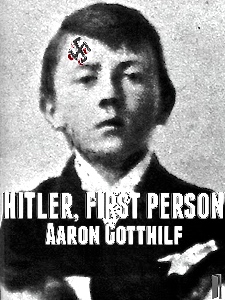“When he embarked on his ambitious…project of writing about Hitler in the first person, [Aaron Gotthilf] sincerely believed that…giving voice to Hitler [was] not only a legitimate literary device that should be accepted in the framework of the principle of freedom of expression but an important tool in advancing our understanding of the horrors of the twentieth century. ‘Hitler was a human being,’ he stress[ed], ‘and as such, he is not beyond the bounds of explanation.’ ”
 In this stimulating experimental novel in which Israeli author Gail Hareven plays with the boundaries of reality and fiction, truth and lies, Aaron Gotthilf’s book, Hitler, First Person plays a key role. Whether or not an Aaron Gotthilf really existed and whether or not his book was real is irrelevant to the writing of Hareven’s book and its themes. Most readers here will probably agree that a fictional depiction of Adolf Hitler as a “real,” and presumably sympathetic, human being would be too small a gesture to “advance our understanding of the horrors of the twentieth century” in any meaningful way, but the idea that it might is just one of the many twists, turns, ironies, tours de force, and even dark-humored reversals that take place in this extraordinary novel. To tell her own story, Hareven creates another author, Elinor Gotthilf from Jerusalem, who is a cousin, once removed, of the “Aaron Gotthilf” who wrote one of the most controversial novels ever published, a book published and circulated in Europe, but never released in Israel. One important Holocaust researcher described this book as a “vile piece of filth not worthy of relating to.”
In this stimulating experimental novel in which Israeli author Gail Hareven plays with the boundaries of reality and fiction, truth and lies, Aaron Gotthilf’s book, Hitler, First Person plays a key role. Whether or not an Aaron Gotthilf really existed and whether or not his book was real is irrelevant to the writing of Hareven’s book and its themes. Most readers here will probably agree that a fictional depiction of Adolf Hitler as a “real,” and presumably sympathetic, human being would be too small a gesture to “advance our understanding of the horrors of the twentieth century” in any meaningful way, but the idea that it might is just one of the many twists, turns, ironies, tours de force, and even dark-humored reversals that take place in this extraordinary novel. To tell her own story, Hareven creates another author, Elinor Gotthilf from Jerusalem, who is a cousin, once removed, of the “Aaron Gotthilf” who wrote one of the most controversial novels ever published, a book published and circulated in Europe, but never released in Israel. One important Holocaust researcher described this book as a “vile piece of filth not worthy of relating to.”
Elinor tells her own story in the first person, explaining that she has avoided her cousin Aaron for most of her adult life. When she was a young student and Aaron needed a place to write his book, he had stayed at her family’s “Pension Gotthilf,” a modest hotel, and she equates his stay there with the Devil/Serpent inserting himself into the Garden of Eden, images which repeat on many levels throughout the novel. It gives nothing away to say that while he was at the pension writing, he abused Elinor’s “slow” older sister Elisheva, requiring her to read The 120 Days of Sodom aloud to him and repeatedly raping her. Her sister’s abortion, her mother’s mental breakdown, and the dissolution of her family were sad by-products of this abuse. Now Aaron, whom she calls “Not-Man,” plans to return to Jerusalem from abroad to attend a writing conference, and though he has publicly recanted his former beliefs about Hitler, claiming that he is working on another book in which he refutes everything he has said in the past, Elinor fears for the future.
Hareven’s approach to her novel is thoughtful and literary, despite the novel’s surprises and reversals. She incorporates a broad artistic and philosophical history within its structure, and though the novel contains some elements of a mystery novel, these are subordinated to the stories and experiences of the people, especially Elinor, who live within the novel and grow (or not) from their actions as they confront their own hatred during their search for justice and truth. In a great irony, Elinor warns the reader that “You should never believe writers, even when they pretend to be telling the truth. Everything that’s written here is pure fiction.” She goes on to say that “None of the characters that appear here, myself included, are real.” But as the reader is digesting all this, Elinor also informs us that her husband is a lawyer and that she has written this disclaimer at the front of the novel on his advice.

The Basilica of the Agony, also known as The Church of All Nations in Jerusalem, is where Alice has an adventure near the conclusion of the book. This is “the place where the fear of death had come upon Jesus.”
For many years, Elinor has been the author of a newspaper series about Alice, a young girl, an alterego of sorts, about whom she has written hundreds of columns over the years as Alice travels from place to place, reporting on what she sees. Naive and clueless, Alice is “ignorant of our great stern beliefs, ignorant of the history and customs of the place,” much like Alice in Wonderland. Elinor, her creator, on the other hand, thinks of herself as grounded in reality. She has been married for over twenty-five years to Oded Brandeis, a successful lawyer, and they have two sons, who are studying in the US. When Elinor discovers that Aaron has tracked down her family and would like to reconnect, she takes a leave from her “Alice columns” and determines to go to the US to warn her sister Elisheva that Aaron may also be searching for her. Elisheva, now happily married is living in the US and enjoying a peaceful life and her role as mother to a young daughter.

Aaron Westerman, who posted this photo, has posted a rave review of Hareven’s novel on his own site. Double click to get to it.
On the plane to the US to see her sister, Elinor reads Hitler, First Person, one of the crazy high points of the novel. “Surrealistic memories and visions of death” remind her of Salvador Dali, as the morbid focus on death and the possibility of necrophilia causes the speaker of Hitler to observe his dying comrades with “spellbound” interest.” He imagines great conflagrations, sees himself as Jesus, but includes monologues by Satan.
When, upon Elinor’s later return to Jerusalem, Elinor’s father-in-law receives an invitation to attend a talk by Aaron Gotthilf at the conference, he suggests that “None of us is pure and we are all influenced by considerations of personal interest.” Elinor, offended by the idea that we all have a little bit of Hitler inside us, responds by contrasting him to George Orwell who fought both the Fascists and the Bolsheviks, endured censorship for being truthful, never “ignored or concealed [the truth]…and [has] always been able to recognize Satan in all his disguises.” She wants no forgiveness for Aaron Gotthilf on any level.

Photo of George Orwell by Deviant Art. George Orwell is used by Elinor as an example of a writer who abides by his values, unlike Aaron Gotthilf.
The novel moves back and forth and around in circular fashion, and while the characters are thin, the author has created a novel which is a never-ending source of surprise and intrigue. Ultimately, Elinor and Oded develop a plan to deal with Aaron Gotthilf when/if they meet him, and as they put their plan into action, the author creates an electrifying conclusion filled with dark irony and an unusual twist. Hareven raises the question of whether, if ever, it is possible to forgive someone like Hitler, and whether it is appropriate to do so, keeping the issues of evil and forgiveness front and center and the novel’s focus on serious moral and ethical issues. On my Favorites List, 2015.
Note: Dalya Bilu’s lively translation preserves the novel’s dark humor at the same time that it reflects the seriousness of the themes.
Photos, in order: The author’s photo by Ouria Tadmor appears on http://forward.com/articles
The 120 Days of Sodom by the Marquis de Sade is shown on https://justanotherbookworm.wordpress.com
The photo of the Basilica of the Agony, also known as the Church of All Nations, in Gethsemane, is by Poco a poco – “Own work. Licensed under CC BY-SA 3.0 via Wikimedia Commons” – and may be found at http://commons.wikimedia.org/ This is the place where Alice has an adventure during the time that Elinor and Oded are dealing with the arrival of Aaron Gotthilf in Jerusalem. Alice’s story of three men – the Jew, the Christian, and the Muslim – is a dark classic.
The cover of Hitler, First Person is from http://www.typographicalera.com/lies-first-person-gail-hareven/ Aaron Westerman’s rave review of Hareven’s book includes this photo of Gotthilf’s book cover.
George Orwell is used by Elinor as an example of a writer who abides by his values, unlike Aaron Gotthilf. Orwell, who had fought both the Bolsheviks and the Fascists, “hadn’t beautified any aspect of reality and hadn’t covered anything up, and…he had seen what others preferred not to see, and…he hadn’t ignored or concealed, and…he had always been able to recognize Satan in all is disguises. Photo here: http://airshipdaily.com
ARC: Open Letter


